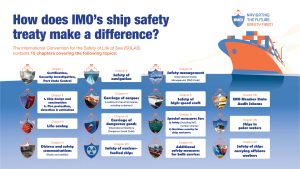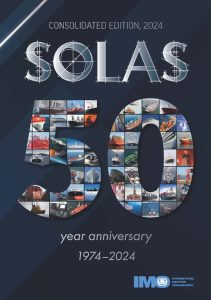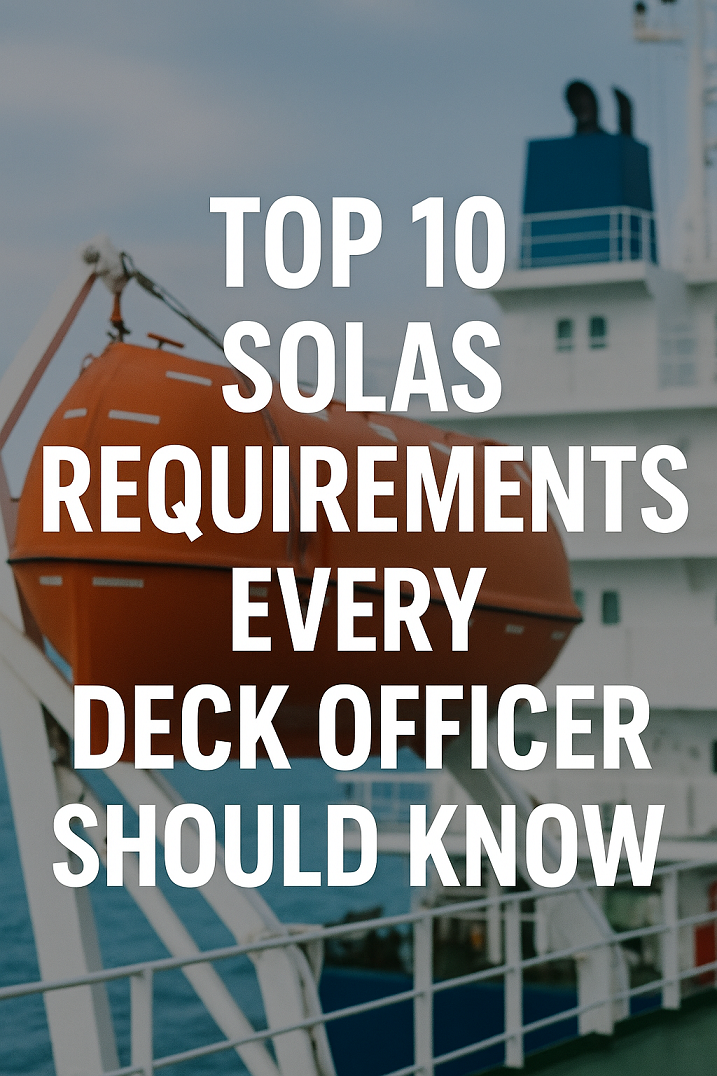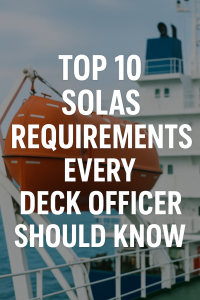Discover the top 10 SOLAS requirements every deck officer must know in 2025. From lifesaving appliances to fire safety systems, learn how SOLAS shapes safer, more compliant maritime operations.
Why SOLAS Matters in Modern Maritime Operations
The International Convention for the Safety of Life at Sea (SOLAS) is widely regarded as the most important international treaty governing maritime safety. Initially adopted in response to the Titanic disaster in 1914, SOLAS has since evolved into a dynamic framework that dictates nearly every safety aspect aboard a commercial vessel—from fire protection and life-saving appliances to navigational standards and structural integrity.
For deck officers, SOLAS isn’t just regulatory background noise—it’s a day-to-day guidebook for ensuring vessel safety, protecting crew, and preventing disasters. Understanding and applying key SOLAS requirements is critical, especially during Port State Control (PSC) inspections, audits, and emergency situations.
This article explores the top 10 SOLAS requirements every deck officer must know, reinforced by real-world examples and practical insights from active maritime operations in 2025.
1. Fire Detection and Firefighting Systems (SOLAS Chapter II-2)
Why It Matters: Fires at sea can escalate rapidly, making early detection and containment essential.
Deck officers must be intimately familiar with:
-
The location and operation of fixed firefighting systems (CO₂, foam, water mist)
-
Portable extinguishers and hydrant layouts
-
Fire control plans and emergency shutdown systems
Case Insight: In 2023, a PSC inspection in Rotterdam led to a container ship’s detention after multiple fire doors were found to be non-functional. The crew had not conducted weekly tests—a SOLAS requirement under Regulation 14.2.2.
Resource: SOLAS Chapter II-2 – Fire Protection, Detection and Extinction
2. Life-Saving Appliances and Arrangements (SOLAS Chapter III)
Why It Matters: In a crisis, the proper use of life-saving equipment is the difference between survival and disaster.
Officers must ensure:
-
Lifeboats, liferafts, and launching appliances are tested weekly
-
Pyrotechnics and lifejackets are within expiry
-
Emergency drills (abandon ship, man overboard) are conducted regularly
Update: From 2024, the IMO requires all lifeboat release mechanisms to comply with the LSA Code Amendment Resolution MSC.402(96), ensuring safer deployment.
3. Navigation Equipment and Bridge Procedures (SOLAS Chapter V)
Why It Matters: Navigation errors are a leading cause of collisions and groundings.
Requirements include:
-
Functional Electronic Chart Display and Information System (ECDIS)
-
Updated nautical charts and publications
-
Testing of gyrocompasses, radars, AIS, and VDR
-
Night-time bridge watch routines and lookout requirements
Real-World Example: A general cargo ship was grounded off the Norwegian coast in 2022 due to outdated ECDIS software. The officer on watch had ignored bridge procedures, violating SOLAS Regulation V/19.2.
4. Emergency Power and Lighting (SOLAS Chapter II-1)
Why It Matters: In emergencies, power loss can paralyze ship systems.
Deck officers must verify:
-
Emergency generators can start automatically
-
Battery systems are charged and tested
-
Emergency lighting in escape routes is operational
Tip: Weekly emergency generator tests and switchboard simulations prepare crews for real-life failures and are mandatory under SOLAS Regulation 42.
5. Structural Fire Protection and Escape Routes
Related Regulation: SOLAS II-2/13
Why It Matters: Clear, accessible escape routes ensure safe evacuation during onboard emergencies.
Officers should check:
-
Fire doors close automatically and seal
-
Escape routes are clearly marked and illuminated
-
Smoke detectors are functional in all accommodation and engine spaces
Incident Highlight: A ferry was fined in 2024 after PSC inspectors found escape hatches in the accommodation blocked with spare parts, a clear breach of Regulation II-2/13.3.2.5.
6. Stability Information and Damage Control (SOLAS Chapter II-1)
Why It Matters: A ship’s stability affects both navigation and survivability in adverse conditions.
Deck officers must:
-
Understand and apply damage control procedures
-
Access the ship’s stability booklet and loading software
-
Know how to use bilge pumps and watertight doors
Note: SOLAS Regulation 25 mandates that all tankers must have onboard damage control plans and stability data—verified during inspections and drills.
7. Emergency Preparedness and Safety Management (SOLAS + ISM Code)
Why It Matters: A well-trained crew responds faster and more effectively during crises.
Officers must:
-
Be trained in all aspects of the ship’s Safety Management System (SMS)
-
Coordinate drills: fire, collision, abandon ship, piracy
-
Maintain updated muster lists and safety duties
Regulatory Note: SOLAS Regulation III/19 requires all drills to be logged and reviewed as part of continuous improvement under the ISM Code.
8. Maritime Security (SOLAS Chapter XI-2 + ISPS Code)
Why It Matters: Unauthorized access can lead to theft, sabotage, or terrorism.
Deck officers need to:
-
Monitor gangway access
-
Verify the Ship Security Alert System (SSAS)
-
Conduct ship security drills and log them appropriately
Current Update: Following cyber threats in 2023, ISPS-compliant systems are now being integrated with shipboard IT protocols as recommended in IMO Circular MSC-FAL.1/Circ.3.
9. Fire Control Plans and Safety Signage
Why It Matters: Visual cues guide crew and rescuers during emergencies.
Deck officers are responsible for:
-
Ensuring fire plans are posted at the bridge and accommodation entrances
-
Verifying all signage follows IMO symbol standards
-
Updating deck layouts after modifications
Compliance Tip: Use Class-approved digital safety mapping tools to keep diagrams synchronized with onboard changes.
10. Communication Equipment and GMDSS
Why It Matters: Reliable communication is essential for safety and coordination.
Officers must check:
-
VHF, MF/HF radios, INMARSAT, NAVTEX, and EPIRBs are operational
-
Daily radio tests are logged as per SOLAS IV/15
-
Crew is trained to transmit distress messages under GMDSS protocols
Real-World Use: During a storm in the South China Sea, a merchant vessel was able to call for SAR assistance using a GMDSS-approved INMARSAT terminal, preventing loss of life.

International Convention for the Safety of Life at Sea (SOLAS), 1974
Adoption: 1 November 1974; Entry into force: 25 May 1980
The SOLAS Convention in its successive forms is generally regarded as the most important of all international treaties concerning the safety of merchant ships. The first version was adopted in 1914, in response to the Titanic disaster, the second in 1929, the third in 1948, and the fourth in 1960. The 1974 version includes the tacit acceptance procedure – which provides that an amendment shall enter into force on a specified date unless, before that date, objections to the amendment are received from an agreed number of Parties.
As a result the 1974 Convention has been updated and amended on numerous occasions. The Convention in force today is sometimes referred to as SOLAS, 1974, as amended.
Technical provisions
The main objective of the SOLAS Convention is to specify minimum standards for the construction, equipment and operation of ships, compatible with their safety. Flag States are responsible for ensuring that ships under their flag comply with its requirements, and a number of certificates are prescribed in the Convention as proof that this has been done. Control provisions also allow Contracting Governments to inspect ships of other Contracting States if there are clear grounds for believing that the ship and its equipment do not substantially comply with the requirements of the Convention – this procedure is known as port State control. The current SOLAS Convention includes Articles setting out general obligations, amendment procedure and so on, followed by an Annex divided into 14 Chapters.
Chapter I – General Provisions
Includes regulations concerning the survey of the various types of ships and the issuing of documents signifying that the ship meets the requirements of the Convention. The Chapter also includes provisions for the control of ships in ports of other Contracting Governments.
Chapter II-1 – Construction – Subdivision and stability, machinery and electrical installations
The subdivision of passenger ships into watertight compartments must be such that after assumed damage to the ship’s hull the vessel will remain afloat and stable. Requirements for watertight integrity and bilge pumping arrangements for passenger ships are also laid down as well as stability requirements for both passenger and cargo ships.
The degree of subdivision – measured by the maximum permissible distance between two adjacent bulkheads – varies with ship’s length and the service in which it is engaged. The highest degree of subdivision applies to passenger ships.
Requirements covering machinery and electrical installations are designed to ensure that services which are essential for the safety of the ship, passengers and crew are maintained under various emergency conditions.
“Goal-based standards” for oil tankers and bulk carriers were adopted in 2010, requiring new ships to be designed and constructed for a specified design life and to be safe and environmentally friendly, in intact and specified damage conditions, throughout their life. Under the regulation, ships should have adequate strength, integrity and stability to minimize the risk of loss of the ship or pollution to the marine environment due to structural failure, including collapse, resulting in flooding or loss of watertight integrity.
Chapter II-2 – Fire protection, fire detection and fire extinction
Includes detailed fire safety provisions for all ships and specific measures for passenger ships, cargo ships and tankers.
They include the following principles: division of the ship into main and vertical zones by thermal and structural boundaries; separation of accommodation spaces from the remainder of the ship by thermal and structural boundaries; restricted use of combustible materials; detection of any fire in the zone of origin; containment and extinction of any fire in the space of origin; protection of the means of escape or of access for fire-fighting purposes; ready availability of fire-extinguishing appliances; minimization of the possibility of ignition of flammable cargo vapour.
Chapter III – Life-saving appliances and arrangements
The Chapter includes requirements for life-saving appliances and arrangements, including requirements for life boats, rescue boats and life jackets according to type of ship. The International Life-Saving Appliance (LSA) Code gives specific technical requirements for LSAs and is mandatory under Regulation 34, which states that all life-saving appliances and arrangements shall comply with the applicable requirements of the LSA Code.
Chapter IV – Radiocommunications
The Chapter incorporates the Global Maritime Distress and Safety System (GMDSS). All passenger ships and all cargo ships of 300 gross tonnage and upwards on international voyages are required to carry equipment designed to improve the chances of rescue following an accident, including satellite emergency position indicating radio beacons (EPIRBs) and search and rescue transponders (SARTs) for the location of the ship or survival craft.
Regulations in Chapter IV cover undertakings by contracting governments to provide radiocommunication services as well as ship requirements for carriage of radiocommunications equipment. The Chapter is closely linked to the Radio Regulations of the International Telecommunication Union.
Chapter V – Safety of navigation
Chapter V identifies certain navigation safety services which should be provided by Contracting Governments and sets forth provisions of an operational nature applicable in general to all ships on all voyages. This is in contrast to the Convention as a whole, which only applies to certain classes of ship engaged on international voyages.
The subjects covered include the maintenance of meteorological services for ships; the ice patrol service; routeing of ships; and the maintenance of search and rescue services.
This Chapter also includes a general obligation for masters to proceed to the assistance of those in distress and for Contracting Governments to ensure that all ships shall be sufficiently and efficiently manned from a safety point of view.
The chapter makes mandatory the carriage of voyage data recorders (VDRs) and automatic ship identification systems (AIS).
Chapter VI – Carriage of Cargoes
The Chapter covers all types of cargo (except liquids and gases in bulk) “which, owing to their particular hazards to ships or persons on board, may require special precautions”. The regulations include requirements for stowage and securing of cargo or cargo units (such as containers). The Chapter requires cargo ships carrying grain to comply with the International Grain Code.
Chapter VII – Carriage of dangerous goods
The regulations are contained in three parts:
Part A – Carriage of dangerous goods in packaged form – includes provisions for the classification, packing, marking, labelling and placarding, documentation and stowage of dangerous goods. Contracting Governments are required to issue instructions at the national level and the Chapter makes mandatory the International Maritime Dangerous Goods (IMDG) Code, developed by IMO, which is constantly updated to accommodate new dangerous goods and to supplement or revise existing provisions.
Part A-1 – Carriage of dangerous goods in solid form in bulk – covers the documentation, stowage and segregation requirements for these goods and requires reporting of incidents involving such goods.
Part B covers Construction and equipment of ships carrying dangerous liquid chemicals in bulk and requires chemical tankers to comply with the International Bulk Chemical Code (IBC Code).
Part C covers Construction and equipment of ships carrying liquefied gases in bulk and gas carriers to comply with the requirements of the International Gas Carrier Code (IGC Code).
Part D includes special requirements for the carriage of packaged irradiated nuclear fuel, plutonium and high-level radioactive wastes on board ships and requires ships carrying such products to comply with the International Code for the Safe Carriage of Packaged Irradiated Nuclear Fuel, Plutonium and High-Level Radioactive Wastes on Board Ships (INF Code).
The chapter requires carriage of dangerous goods to be in compliance with the relevant provisions of the International Maritime Dangerous Goods Code (IMDG Code).
Chapter VIII – Nuclear ships
Gives basic requirements for nuclear-powered ships and is particularly concerned with radiation hazards. It refers to detailed and comprehensive Code of Safety for Nuclear Merchant Ships which was adopted by the IMO Assembly in 1981.
Chapter IX – Management for the Safe Operation of Ships
The Chapter makes mandatory the International Safety Management (ISM) Code, which requires a safety management system to be established by the shipowner or any person who has assumed responsibility for the ship (the “Company”).
Chapter X – Safety measures for high-speed craft
The Chapter makes mandatory the International Code of Safety for High-Speed Craft (HSC Code).
Chapter XI-1 – Special measures to enhance maritime safety
The Chapter clarifies requirements relating to authorization of recognized organizations (responsible for carrying out surveys and inspections on Administrations’ behalves); enhanced surveys; ship identification number scheme; and port State control on operational requirements.
Chapter XI-2 – Special measures to enhance maritime security
Regulation XI-2/3 of the chapter enshrines the International Ship and Port Facilities Security Code (ISPS Code). Part A of the Code is mandatory and part B contains guidance as to how best to comply with the mandatory requirements. Regulation XI-2/8 confirms the role of the Master in exercising his professional judgement over decisions necessary to maintain the security of the ship. It says he shall not be constrained by the Company, the charterer or any other person in this respect.
Regulation XI-2/5 requires all ships to be provided with a ship security alert system. ,Regulation XI-2/6 covers requirements for port facilities, providing among other things for Contracting Governments to ensure that port facility security assessments are carried out and that port facility security plans are developed, implemented and reviewed in accordance with the ISPS Code. Other regulations in this chapter cover the provision of information to IMO, the control of ships in port, (including measures such as the delay, detention, restriction of operations including movement within the port, or expulsion of a ship from port), and the specific responsibility of Companies.
Chapter XII – Additional safety measures for bulk carriers
The Chapter includes structural requirements for bulk carriers over 150 metres in length.
Chapter XIII – Verification of compliance
Makes mandatory from 1 January 2016 the IMO Member State Audit Scheme.
Chapter XIV – Safety measures for ships operating in polar waters
The chapter makes mandatory, from 1 January 2017, the Introduction and part I-A of the International Code for Ships Operating in Polar Waters (the Polar Code).
Chapter XV – Safety measures for ships carrying industrial personnel (Entry into force: 1 July 2024)
The aim is to provide minimum safety standards for ships that carry industrial personnel, as well as for the personnel themselves, and address specific risks of maritime operations within the offshore and energy sectors, such as personnel transfer operations. Such personnel may be engaged in the construction, maintenance, decommissioning, operation or servicing of offshore facilities, such as windfarms, as well as offshore oil and gas installations, aquaculture, ocean mining or similar activities.
Amendments
The 1974 Convention has been amended many times to keep it up to date. See History of SOLAS.
Amendments adopted by the Maritime Safety Committee (MSC) are listed in MSC Resolutions.

Case Studies: SOLAS in Action
Case Study 1: Preventing Fire Escalation on a Container Ship
A vigilant deck officer aboard a containership spotted smoke from a reefer plugboard. Immediate response with CO₂ and sealing of the space prevented a major fire. PSC officers later commended the crew’s drill efficiency and SOLAS compliance.
Case Study 2: PSC Detention Due to Lifeboat Lapse
A Ro-Ro ferry was detained in Valencia in 2024 after crew failed to launch lifeboats within SOLAS-required times during a PSC surprise drill. The cause? Corroded davit wires and lack of recent training.
Frequently Asked Questions (FAQ)
1. What is the most important SOLAS chapter for deck officers?
While all chapters are vital, Chapter III (Life-Saving Appliances) and Chapter V (Safety of Navigation) are most directly relevant to daily bridge and emergency operations.
2. How often are SOLAS drills required?
Abandon ship and fire drills are required weekly, with lifeboat launching at least once every three months.
3. Do deck officers need to memorize SOLAS regulations?
No, but they must be familiar with key requirements relevant to their duties and know where to find updates and ship-specific procedures.
4. Can a ship operate with expired fire equipment if noted for replacement?
No. Expired safety equipment constitutes a detainable deficiency and violates SOLAS requirements, regardless of pending orders.
5. How is SOLAS enforced during inspections?
PSC, flag state, and class society inspectors verify compliance via drills, records, and equipment testing. Non-compliance can lead to detentions, fines, and operational delays.
Conclusion
SOLAS is more than a legal document—it’s a lifeline for those at sea. For deck officers, mastering its top requirements means staying alert, prepared, and capable of protecting both crew and cargo. From lifesaving gear and firefighting systems to bridge procedures and security drills, SOLAS ensures that safety isn’t just a checkbox—it’s a culture.
In an industry shaped by regulation and risk, understanding SOLAS deeply is both a professional responsibility and a matter of life and death. Stay updated. Train continuously. And lead by example—because safety begins with you.
References
-
IMO. (2024). SOLAS Consolidated Edition. https://www.imo.org
-
Lloyd’s Register. (2023). SOLAS Compliance Guide for Operators. https://www.lr.org
-
DNV. (2024). Fire Safety Systems on Ships. https://www.dnv.com
-
Paris MoU. (2023). Annual PSC Report. https://www.parismou.org
-
The Nautical Institute. (2023). SOLAS Training for Officers. https://www.nautinst.org
-
ClassNK. (2023). Lifeboat Maintenance and Drill Standards.
-
ABS. (2024). SOLAS Navigation Equipment Audit Checklist. https://www.eagle.org



THANK YOU !